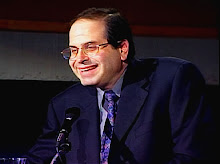(Photo credit: David Shankbone - Creative Commons license)
Evans has very recently published a memoir covering his years as a newspaperman and book publisher, in which he discusses the advertising campaign for Case Closed. ("My Paper Chase: True Stories of Vanished Times," Little, Brown and Company. New York: 2009.) I report it here not because he needs the publicity -- he's more of an expert than I am on that score -- but because it establishes two points: (1) the anti-competitive nature of the campaign, and (2) the extreme handicap that the federal judiciary placed upon Mr. Groden by denying him any and all manner of discovery to buttress his case against the defendants. After a civil lawsuit commences, either of the parties may use the discovery procedures prescribed by the Federal Rules of Civil Procedure to obtain facts and information about the case from each other, or from third persons who are non-parties to the lawsuit. These procedures may include depositions; demands that the other side (or non-parties) produce relevant documents; written interrogatories; and requests for admissions. Such procedures enable the parties to prepare to make or oppose motions and, eventually, try the case before a jury. Evans' memoir makes it clear that the denial of discovery from the outset of the case essentially relegated Groden to pressing his merits with both hands tied behind his back.
A brief word about what was known in 1993-94 is in order: The field of assassination books scheduled for publication in the Fall of 1993 was crowded. In addition to Posner's book, it included Mr. Groden's first, eagerly anticipated solo effort, The Killing of a President. Pre-publication media coverage included such articles as one that appeared in The Orlando Star Sentinel: "The two titles that are likely to command the most attention take opposite points of view. . . . Look for Posner and Groden to duke it out on talk shows." (The Orlando Sentinel, July 4, 1993 Sunday, 3 Star, Arts & Entertainment; Pg. D8.) Earlier that Spring, a major feature article in Publishers Weekly, the industry bible, had previewed the assassination books scheduled for Fall publication. Groden's editor, Michael Fragnito, editorial director of Viking Studio Books, was quoted as follows: "'Robert calls this a howdunit, not a whodunit,' continues Fragnito. 'He's not one of those wacko assassination buffs. His point is that a conspiracy occurred, but he doesn't claim to know who the participants were.'" (Dahlin, Robert, "Assassination anniversary marked by 'definitive' works; John F. Kennedy," Publishers Weekly, May 3, 1993, Vol. 240; No. 18; Pg. 33.) That description of Groden's work will begin to assume large significance in my next post.
It is now evident that Evans worried over the impact of Groden's forthcoming book, and how to make Posner's stand out. He writes:
Everywhere around town when I mentioned that we had a sensation, I got the same response: "Not another Kennedy book! Give us a break!" Bookstore buyers reacted the same way. How could we make people pay attention when the sensation was that there was no sensation? Clearly we had a big marketing problem.My Paper Chase at 527. And Evans continues:
I became so exasperated, I quite lost my temper over lunch with a publisher from London when I was told yet again that the public had passed the point of satiation on the death of Kennedy. "We're naming the guilty men!" I cried out. The publisher sat up. "You mean the men behind the killing? Wow, that is something!" No, I said, the guilty men are all those who ignored the evidence and misled the world. I was grateful to the publisher. He'd provoked me not a spur-of-the-moment response that might solve the marketing problem. On the napkin I roughed out the outline of an advertising campaign, leading off with a big GUILTY splashed across photographs of the principal propagators of conspiracy. We made that the overture to the campaign, backed up by a special U.S. News & World Report prepublication issue. The result was spectacular."My Paper Chase at 528. Here was Evans' "overture":
And here is a representative illustration of the four subsequent ads that appeared in The New York Times:
It was all a marketing ploy because booksellers did not want to order the book, believing that the market was satiated. Evans was looking for a dramatic and attention-getting way to publicize Posner's book because Posner had no previous public association with the subject of Kennedy's assassination and was not a widely known author. The keys to Evans' mindset were his passionate antipathy toward critics of the Warren Report, and his urge to sensationalize Posner's book, because he understood there was nothing extraordinary about a book endorsing the Warren Commission's conclusion. He could not sell Case Closed without mounting a standout attack advertising campaign. Interestingly, Evans also reveals that he was warned Random House would be sued for the ads, which may imply his desperation and willingness to risk defying the law for the sake of promoting his precious book. For Evans, the ends justified the means, and he remains unapologetic. It bothers this publishing industry icon none that his despicable tactics succeeded in suppressing another writer's work, or that his outrageous publicity campaign distracted public attention away from the National Archives' release of the files of the House Select Committee on Assassinations. Were these among his conscious objectives? Where others would try to hide their shame, Evans beats his seething breast with pride. The cruel irony of it all is that Evans has been known to castigate his fellow journalists for insufficient skepticism about official pronouncements, e.g., for "drinking the Kool-Aid," yet he cannot explain why the mainstream media in the United States obsequiously adopted the Warren Report and failed to conduct their own investigations of the assassination.



